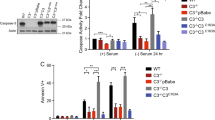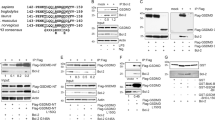Abstract
The function of key components of signal transduction, the Src family tyrosine kinases is dependent on catalytic activity as well as on intermolecular interaction achieved by their SH2 and SH3 modular domains. We have analyzed the effect of overexpression of the hematopoietic cell kinase (Hck) and its N-terminal unique and SH3 domains on cell survival. Overexpression of the N-terminal unique and SH3 domains (Hck-USH3) induced about 25% of expressing Cos-1 cells to undergo apoptosis 30 hrs after transfection. The full length p59 and p56 forms and the unique domain alone induced low levels of cell death. The unique and SH3 domain of a closely related kinase, Lyn did not induce apoptosis. Overexpression of a mutant USH3 domain (Gly → Ala), that disrupts membrane localization, did not induce high level of apoptosis. Cells overexpressing Hck-USH3 showed activation of caspase-3 and release of cytochrome c from mitochondria into cytosol. Caspase-3 defective MCF-7 cells were resistant to apoptosis and cytochrome c release induced by Hck-USH3, which were restored by introducing the caspase-3 gene. These results suggest that Hck SH3 domain mediated signalling at the plasma membrane triggers a pathway leading to caspase-3 dependent cyto- chrome c release and apoptosis.
Similar content being viewed by others
References
Jacobson MD, Weil M, Raff MC Programmed cell death in animal development. Cell 1997; 88: 347–354.
Barr PJ, Tonei LD Apoptosis and its role in human disease. Biotechnology 1994; 12: 487–493.
Thompson CB Apoptosis in the pathogenesis and treatment of disease. Science 1995; 267: 1456–1462.
Stellar H Mechanism and genes of cellular suicide. Science 1995; 267: 1445–1449.
Jarpe MB, Widmann C, Knall C, et al. Antiapoptotic versus proapoptotic signal transduction checkpoints and stop signs along road to death. Oncogene 1998; 17: 1475–1482.
Earnshaw WC, Martins LM, Kaufmann SH Mammalian caspases: Structure, activation, substrates and functions during apoptosis. Ann Rev Biochem 1999; 68: 383–424.
Slee E, Adrain C, Martin SJ Serial killers: Ordering caspase activation events in apoptosis. Cell Death and Differen 1999; 6: 1067–1074.
Zheng TS, Hunot S, Kuida K, Flawell RA Caspase knockouts: Matters of life and death. Cell Death and Differen 1999; 6: 1043–1053.
Li P, Nijhawan D, Dudihardjo I, et al. CytochromeCand dATPdependent formation of Apaf-1/caspase-9 complex initiates an apoptotic protease cascade. Cell 1997b; 91: 479–389.
Nicholson DW Caspase structure, proteolytic substrates, and function during apoptotic cell death. Cell Death and Differen 1999; 6: 1028–1042.
Yang C, Chang J, Gorospe M, Passaniti A Protein tyrosine phosphatase regulation of endothelial cell apoptosis and differentiation. Cell Growth&Differen 1996; 7: 161–171.
Neel BG, Tonks NK Protein tyrosine phosphatases in signal transduction. Curr Op Cell Biol 1997; 9: 193–204.
Radha V, Sudhakar Ch, Swarup G Induction of p53 dependent apoptosis upon overexpression of a nuclear protein tyrosine phosphatase. FEBS Letts 1999; 453: 308–312.
Wei S, Liu JH, Epling-Burnette PK, et al. Critical role of Lyn kinase in inhibition of neutrophil apoptosis by GM-CSF. J Immunol 1996; 157: 5155–5162.
Yousefi S, Hoessli DC, Blaser K, Mills GB, Simon HU Requirement of Lyn and Syk tyrosine kinases for the prevention of apoptosis by cytokines in human eosinophils. J Exp Med 1996; 183: 1407–1414.
Thomas SM, Brugge JS Cellular functions regulated by Src family kinases. Ann Rev Cell Dev Biol 1997; 13: 513–609.
Simon HU, Yousefi S, Dibbert B, et al. Role of tyrosine phosphorylation and Lyn tyrosine kinase in Fas receptor mediated apoptosis in eosinophils. Blood 1998; 92: 547–557.
AL-Ramadi BK, Zhang H, Bothwell ALM Cell cycle arrest and apoptosis hyper susceptibility as a consequence of Lck deficiency in nontrans formed T lymphocytes. Proc Natl Acad Sci 1998; 95: 12498–12503.
Ziegler SF, Marth JD, Lewis DB, Perlmutter RM Novel protein-tyrosine kinase gene (hck) preferentially expressed in cells of hematopoietic origin. Mol Cell Biol 1987; 7: 2276–2285.
Rema V, Swarup G Molecular cloning of a membrane bound tyrosine specific protein kinase from rat spleen. Ind J Biochem Biophys 1990; 27: 433–437.
English BK, Ihle JN, Myracle A, Yi T Hck tyrosine kinase activity modulates TNF production by murine macrophages. J Exp Med 1993; 178: 1017–1022.
Ernst M, Gearing DP, Dunn AR Functional and biochemical association of Hck and the LIF/IL-6 receptor signal transducing subunit gp130 in embryonic stem cells. EMBO J 1994; 13: 1574–1584.
Ghazizadeh S, Bolen JB, Fleit HB Physical and functional association of Src related PTKs and FCrRll in THP-1 cells. J Biol Chem 1994; 269: 8878–8884.
Pawson T Protein modules and signalling networks. Nature 1995; 373: 573–580.
Resh MD Myristylation and palmitylation of Src family members. Cell 1994; 76: 411–413.
Robbins SM, Quintrell NA, Bishop MJ Myristoylation and differential palmitoylation of the Hck PTKs govern their attachment to membranes and association with coveolae. Mol Cell Biol 1995; 15: 3507–3515.
Lock P, Ralph S, Stanley E, Bonlet I, Ramsay R, Dunn AR Two isoforms of murine hck, generated by utilization of alternative translational initiation codons, exhibit different patterns of subcellular localization. Mol Cell Biol 1991; 11: 4363–4370.
Erpel T, Courtneidge SA Src family protein tyrosine kinases and cellular signal transduction pathways. Curr Op Cell Biol 1995; 7: 176–182.
Gouri BSV, Rema V, Kamatkar S, Swarup G Nucleotide sequence of a cDNA coding for rat hck tyrosine kinase and characterization of its gene product. J Biosci 1994; 19: 117–129.
Kamatkar S, Radha V, Nambirajan S, Reddy RS, Swarup G Two splice variants of a tyrosine phosphatase differ in substrate specificity, DNA binding and subcellular location. J Biol Chem 1996; 271: 26755–26761.
Radha V, Nambirajan S, Swarup G Subcellular localization of a PTPase: Evidence for association with chromatin. Biochem J 1994; 299: 41–47.
Juin P, Hueber A, Littlewood T, Evan G c-Myc-induced sensitization to apoptosis is mediated through cytochrome c release. Genes & Develop 1999; 13: 1367–1381.
Tewari M, Dixit VM Fas and TNF-induced apoptosis is inhibited by the poxvirus CrmA gene product. J Biol Chem 1995; 270: 3255–3260.
Zhang J, Alter N, Reed JC, Borner C, Obeid LM, Hannun YA Bcl-2 interrupts the ceramide-mediated pathway of cell death. Proc Natl Acad Sci 1996; 93: 5325–5328.
Tewari M, Quan LT, O'Rourke K, et al. Yama/CPP-32β, a mammalian homolog of CED-3, is a Crm A-inhibitable protease that cleaves the death substrate poly (ADP-ribose) polymerase. Cell 1995; 81: 801–809.
Adams JM, Cory S The Bcl2 protein family: Arbiters of cell survival. Science 1998; 281: 1322–1326.
Newton K, Strasser A The Bcl-2 family and cell death regulation. Curr Op Gen&Dev 1998; 8: 68–75.
Salvesen GS, Dixit VM Caspases: Intracellular signaling by proteolysis. Cell 1997; 91: 443–446.
Porter AG, Janicke RU Emerging roles of caspase-3 in apoptosis. Cell Death Differ 1999; 6: 99–104.
Garcia-Calvo M, Peterson EP, Leiting B, Ruel R, Nicholson DW, Thornberry NA Inhibition of human caspases by peptide based and macromolecular inhibitors. J Biol Chem 1998; 273: 32608–32613.
Janicke RU, Sprengart ML, Wati MR, Porter AG Caspase 3 is required for DNA fragmentation and morphological changes associated with apoptosis. J Biol Chem 1998; 273: 9357–9360.
Woo M, Hakem R, Soengas MS, et al. Essential contribution of caspase-3 to apoptosis and its associated nuclear changes. Genes Dev 1998; 12: 806–819.
Green DR, Reed JC Mitochondria and apoptosis. Science 1998; 281: 1309–1312.
Zou H, Henzel WJ, Liu X, Lutschg A, Womy X Apaf-1, a human protein homologous to C-elegans CED-4 participates in Cyt C. Dependent activation of caspase-3. Cell 1997; 90: 405–413.
Corbeil J, Tremblay M, Rickman D HIV-induced apoptosis requires the CD4 receptor cytoplasmic tail and is accelerated by interaction of CD4 with p56lck. J Exp Med 1996; 183: 39–48.
Kaplan KB, Swedlow JR, Morgan DO, Varmus HE C-Src enhances spreading of Src–/– fibroblasts on fibronectin by a kinase independent mechanism. Genes Dev 1995; 9: 1505–1517.
Kuida K, Zheng TS, Na SQ, et al. Decreased apoptosis in the brain and premature lethality in CPP 32-deficient mice. Nature 1996; 384: 368–372.
Woo M, Haken A, Elia AJ, et al. In vivo evidence that caspase-3 is required for fas-mediated apoptosis of hepatocytes. J Immunol 1999; 163: 4909–4916.
Cosulich SC, Savory PJ, Clarke PR Bcl-2 regulates amplification of caspase activation by cytochrome C. Curr Biol 1999; 9: 147–150.
Bossy-Wetzel E, Green DR Caspases induce cytochrome release from mitochondria by activating cytosolic factors. J Biol Chem 1999; 274: 17484–17490.
Kirsch DG, Dosef A, Chau BN, et al. Caspase-3-dependent cleavage of Bcl-2 promotes release of cytochrome C. J Biol Chem 1999; 274: 21155–21161.
Li F, Anu S, Wang Y, Armstrong RC, Tomasolli KJ, Fritz LC Cell-specific induction of apoptosis by microinjection of cytochrome c. J Biol Chem 1997a; 272: 30299–30305.
Blanc C, Deveraux QL, Krajewski S, et al. Caspase-3 is essential for procaspase-9 processing and cisplatin-induced apoptosis of MCF-7 breast cancer cells. Cancer Res 2000; 60: 4386–4390.
Xing L, Venegas AM, Chen A, et al. Genetic evidence for a role for Src family kinases in TNF family receptor signaling and cell survival. Genes & Devp 2001; 15: 241–253.
Luciano F, Ricci J-E, Auberger P Cleavage of Fyn and Lyn in their N-terminal unique regions during induction of apoptosis: A new mechanism for Src kinase regulation. Oncogene 2001; 20: 4935–4941.
Author information
Authors and Affiliations
Rights and permissions
About this article
Cite this article
Radha, V., Sudhakar, C., Ray, P. et al. Induction of cytochrome c release and apoptosis by Hck-SH3 domain-mediated signalling requires caspase-3. Apoptosis 7, 195–207 (2002). https://doi.org/10.1023/A:1015370512425
Issue Date:
DOI: https://doi.org/10.1023/A:1015370512425




